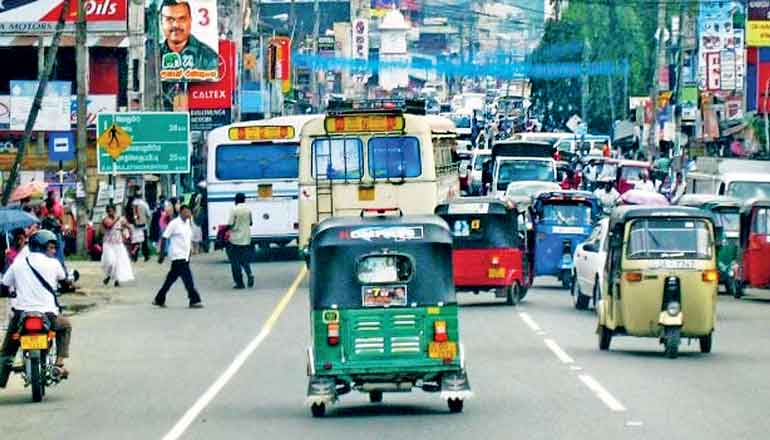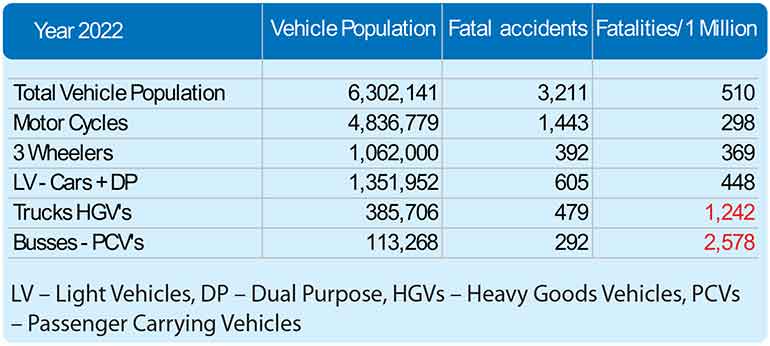Tuesday Apr 29, 2025
Tuesday Apr 29, 2025
Tuesday, 29 April 2025 01:41 - - {{hitsCtrl.values.hits}}

In Sri Lanka, most riders aren’t even taught the basics of safe riding
“There’s a killer on the road…if you give this man a ride, sweet family will die” – Riders on the storm, Jim Morrison and the Doors, 1971.
 A hidden threat on our roads
A hidden threat on our roads
Why do passenger buses drive so aggressively? Most assume drivers are racing for fun. In reality, they are racing to survive. Bus owners set income and arrival-time targets. Salaries and allowances are tied directly to these metrics. If drivers are late, they lose income. As a result, they risk everything — their passengers, pedestrians, even their own lives — just to earn a full paycheckThe numbers don’t add upAccording to the police, there were 24,589 accidents and 2,368 deaths in 2024. In 2022, there were 21,953 accidents and 3,211 deaths. That would imply that in 2024, one in every ten accidents resulted in a fatality — and one in every seven in 2022.Clearly, these figures are misleading.Why? Because only a small fraction of accidents are reported to the police.Insurance companies, by contrast, report around 600,000 accidents annually.The apparent dip in accidents and deaths in 2024 may be due to reduced travel caused by high fuel prices. Traffic in Colombo and suburbs is visibly lower since the economic crisis and its resultant fuel hikes. Have insurance claims dropped too?Why real accident data mattersRoad deaths are a fraction of total accidents. To reduce fatalities, we must reduce all accidents — and that starts with tracking actual numbers.If 600,000 accidents caused 2,368 deaths, that’s one death for every 253 accidents. Reducing annual accidents to 300,000 could save over 1,000 lives each year.If our leaders are serious about change, they must create a real-time accident tracking system — weekly or monthly — using data from insurance companies. Then, we must set and enforce national accident reduction targets.The National Council for Road Safety (roadsafety.gov.lk) should be held accountable for tracking and publishing this data and evaluating the effectiveness of every initiative. What we can do — starting nowThere are several immediate actions that can save lives:1. Mandate daytime running lights for all motorcycles.This simple rule improves visibility and reduces collisions. Many Japanese domestic models have lights permanently on — often disabled when imported to Sri Lanka.2. Enforce strict rest periods for HGV and PCV drivers.Include required breaks and rest time between shifts. A smartphone app could enforce this — where drivers cannot start a journey without fulfilling rest criteria. Owners — not drivers — should face penalties for violation.3. Ban performance-based pay schemes for drivers.Linking pay to speed or passenger numbers incentivise dangerous driving. Owners must be fined for violations.4. Add emergency braking tests for all new motorcycle riders.Riders must demonstrate that they can stop safely under emergency conditions.Long-term changes that must happen
What we can do — starting nowThere are several immediate actions that can save lives:1. Mandate daytime running lights for all motorcycles.This simple rule improves visibility and reduces collisions. Many Japanese domestic models have lights permanently on — often disabled when imported to Sri Lanka.2. Enforce strict rest periods for HGV and PCV drivers.Include required breaks and rest time between shifts. A smartphone app could enforce this — where drivers cannot start a journey without fulfilling rest criteria. Owners — not drivers — should face penalties for violation.3. Ban performance-based pay schemes for drivers.Linking pay to speed or passenger numbers incentivise dangerous driving. Owners must be fined for violations.4. Add emergency braking tests for all new motorcycle riders.Riders must demonstrate that they can stop safely under emergency conditions.Long-term changes that must happen
- Overhaul the driving license system. End the current sham and adopt an internationally recognised standard. Our new highways require drivers to be competent at high speeds and in multi-lane environments. Highway driving must become part of the test.
- Mandatory re-testing after serious accidents. Any driver involved in a major accident should face a quick assessment of competence. Failing that, they must retake their license.
- National education campaigns.
Teach drivers, riders, and pedestrians the basics — like how to respond to emergency vehicles, how to use crosswalks, or why lights should be turned on one hour before sunset and kept on until one hour after sunrise. What to do when traffic slows suddenly on the highway.The time for change is nowPresident AKD has rightly put this issue on the national agenda. But unless we adopt a pragmatic and scientific approach, this humanitarian disaster will continue — because we keep releasing killers on our roads.(The writer is a pioneer solar energy entrepreneur, a former member of the Colombo Municipal Council, a former Sri Lanka Consul General to Germany, and a race car driver with international and national awards and a motorcycle rider.)Discover Kapruka, the leading online shopping platform in Sri Lanka, where you can conveniently send Gifts and Flowers to your loved ones for any event including Valentine ’s Day. Explore a wide range of popular Shopping Categories on Kapruka, including Toys, Groceries, Electronics, Birthday Cakes, Fruits, Chocolates, Flower Bouquets, Clothing, Watches, Lingerie, Gift Sets and Jewellery. Also if you’re interested in selling with Kapruka, Partner Central by Kapruka is the best solution to start with. Moreover, through Kapruka Global Shop, you can also enjoy the convenience of purchasing products from renowned platforms like Amazon and eBay and have them delivered to Sri Lanka.
Recent columns
COMMENTS
Discover Kapruka, the leading online shopping platform in Sri Lanka, where you can conveniently send Gifts and Flowers to your loved ones for any event including Valentine ’s Day. Explore a wide range of popular Shopping Categories on Kapruka, including Toys, Groceries, Electronics, Birthday Cakes, Fruits, Chocolates, Flower Bouquets, Clothing, Watches, Lingerie, Gift Sets and Jewellery. Also if you’re interested in selling with Kapruka, Partner Central by Kapruka is the best solution to start with. Moreover, through Kapruka Global Shop, you can also enjoy the convenience of purchasing products from renowned platforms like Amazon and eBay and have them delivered to Sri Lanka.